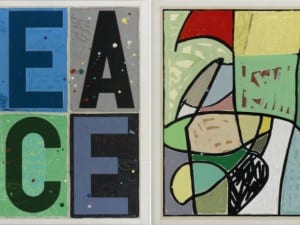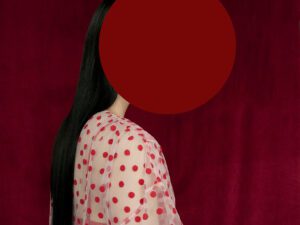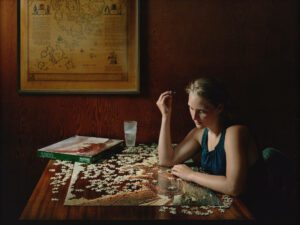Micheal Rosenfeld Gallery, New York, has consistently championed artists for almost three decades, 32 of which are featured in The Time is Now (2017). It is inspired by the slogan which originally appeared on a protest sign on Fifth Avenue in Manhattan, photographed by Otto Bettman (1903) during the Women’s Liberation Parade in 1971. Set into motion by Betty Friedan (1921-2006) (author of The Feminine Mystique, 1963), The Women’s Strike for Equality March was officially sponsored by National Organisation for Women (NOW) who wanted action that would emulate the power and potential of second-wave feminism. This radical show documents an era when, as Time notes, “virtually all of the nation’s systems — industry, unions, the professions, the military, the universities, even the organisations of the New Left — are quintessentially masculine establishments.” The cultural backdrop of 20th century America remains infused with this systemic injustice and social inequality, perhaps more so now than ever, thus the exhibition comes at a particularly relevant point in history.
A private feat of activism, Michael Rosenfeld Gallery was established to present the unfiltered and all-encompassing story of American art. Since its inception in 1989, it has sought to celebrate works eclipsed by European (patri)lineage. With the mission to establish equality within the canon, their long list of exhibitions have highlighted the achievements of artists previously marginalised on the basis of race and gender. This new collective work reclaims the fractured history of colonial and patriarchal oppression.
The Time is Now is curated to expand on the Museum of Modern Art’s, New York, current show Making Space: Women Artists & Post-war Abstraction. Covering the period from 1937 to 1984 the pieces are entrenched in the movements of their time – including the Black Arts and Civil Rights crusades –acting as a microcosm for inter-generational tensions within history. Featured artists thus represent a variety of perspectives and include: Barbara-Chase Riboud, Elaine de Kooning, Claire Falkenstein, Lee Krasner, Yayoi Kusama, Lee Lozano and Nancy Spero. These innovators collectively challenge singular connotations of the term, “women’s art.”
Barbara Chase-Riboud’s (1939) The Albino (1972), is a monumental sculpture and presents one such work that illuminates ground-breaking practice. Built to remain mobile, the structure can be shaped into one of two forms. Presented horizontally, it is characterised by two impressive wings that stem from a central body that rests on the floor. When vertical it forms a tall, totemic pillar and is known as All That Rises Must Converge/Black (1972). Treated as two different sculptures by the art historian Peter Selz, the piece resists singular readings and easy assimilation. By extension, Riboud often incorporates the exhibition space as a sculptural medium. Similarly, the floating dynamism of Claire Falkenstein’s (1908-1997) copper and enamel Sun (1960) harnesses the surroundings as open, liberated spaces.
Kay Sage’s (1898-1963) hauntingly still The Fourteen Daggers (1942), shares a room with Lee Lozano’s (1930-1999) seminal Ram (1964), a large-scale diptych from the Verb Paintings series. Both are characterised by a photographic precision of line and a hyper-reality. Whilst Sage captures the absurd through architectural structures and ethereal, enigmatic settings, Lozano’s oeuvre is a raw mix of comic book-surrealism, a deliberate contrast to the sober, minimalist works that were common in New York in the early 1960s.
If social change is largely about people reclaiming their stories, these pieces triumph by accessing a sense of autonomy. By its very presence, the exhibition subverts the somewhat discriminatory nature of the mainstream world. The displayed pieces become a vantage point for conversations that examine the past and present. In a landscape that often fails to celebrate the diversity of its constituent states, Rosenfeld testifies to the longstanding struggle to establish equality.
The exhibition is open until 4 August. For further information please visit: www.michaelrosenfeldart.com
Credit:
1. Yayoi Kusama, Infinity Mirrors. Courtesy of Hirshhorn Museum.





